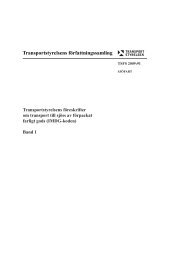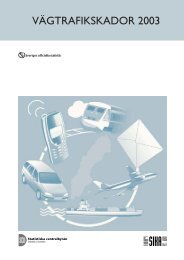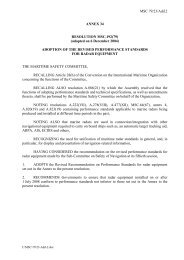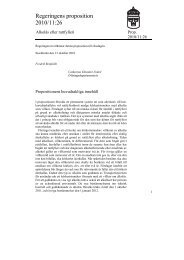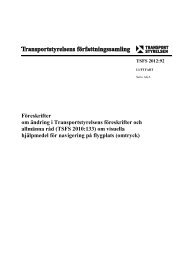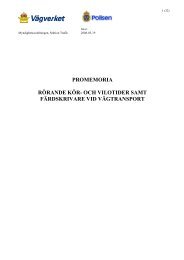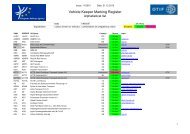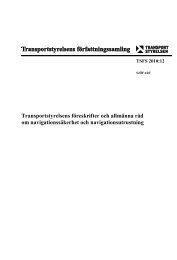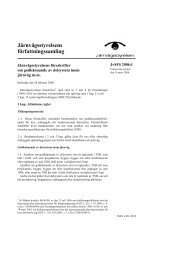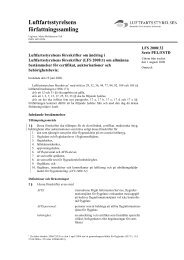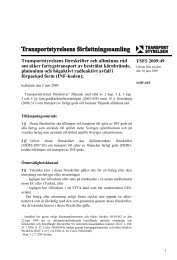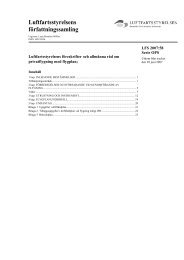Approach Type Height (Feet) Visibility (Metres) Characteristics
Approach Type Height (Feet) Visibility (Metres) Characteristics
Approach Type Height (Feet) Visibility (Metres) Characteristics
You also want an ePaper? Increase the reach of your titles
YUMPU automatically turns print PDFs into web optimized ePapers that Google loves.
APV Baro or LPV SBAS?<br />
APV Barometric<br />
Implemented on large aircraft types.<br />
No independent height check at FAF.<br />
APV SBAS<br />
Currently Implemented on many Business Jets<br />
<strong>Height</strong> check at FAF is independent of the GNSS Geometric height.<br />
UK CAA DAP encouraging inclusion of LNAV, LNAV/VNAV and<br />
LPV minima lines on all charts.<br />
Implementation of additional minima line is a small<br />
incremental cost if undertaken with initial designs compared<br />
with later addition.<br />
Southampton RNAV (GNSS) procedures<br />
Runway 20. LNAV/VNAV OCH 462‟ LPV 250‟<br />
Runway 02 LNAV/VNAV OCH 475‟ LPV 375‟<br />
LNAV/VNAV procedures can be flown by SBAS aircraft to<br />
LNAV/VNAV minima if coded in the database.<br />
SBAS and Barometric <strong>Approach</strong>es are complimentary
ICAO Assembly Resolution A37-11<br />
(Extract) Resolves that:<br />
States and planning and implementation regional groups (PIRGs)<br />
complete a PBN implementation plan by 2009 as a matter of urgency<br />
to achieve:<br />
1) implementation of RNAV and RNP operations (where required) for en<br />
route and terminal areas according to established timelines and intermediate<br />
milestones; and<br />
2) implementation of approach procedures with vertical guidance (APV)<br />
(Baro-VNAV and/or augmented GNSS) for all instrument runway ends,<br />
either as the primary approach or as a back-up for precision approaches by<br />
2016.<br />
The intent of the Resolution is supported by UK CAA, but is not considered to be<br />
a mandate.<br />
A 37-11 is the basis of the ICAO ASBU 0-65 (Optimization of <strong>Approach</strong><br />
Procedures including vertical guidance )<br />
All options in the proposed European PBN Implementing Rule will<br />
require carriage of APV and APV procedures at all instrument runways<br />
by 2020.
TEN-T Project: LPV Operation at Alderney<br />
Aurigny BN 2 Trislander Aircraft<br />
One aircraft fitted with Garmin 430/W<br />
avionics integrated to autopilot.<br />
EASA certified aircraft for LPV Dec. 2011<br />
Aurigny achieved LPV Operational Approval<br />
from CAA Dec. 2011<br />
The first certified operation in Europe<br />
Aurigny now upgrading 5th aircraft with<br />
Garmin GTN 750 and Aspen 1000 EFD.<br />
• BRNAV, PRNAV, LNAV, LPV.<br />
• Terrain Avoidance Warning<br />
• Squitters ADS position.<br />
Slide 4
Benefits at Alderney<br />
<strong>Approach</strong><br />
<strong>Type</strong><br />
NDB NPA<br />
(No DME)<br />
GNSS<br />
LNAV<br />
GNSS<br />
LPV<br />
Slide 5<br />
<strong>Height</strong><br />
(<strong>Feet</strong>)<br />
390<br />
<strong>Visibility</strong><br />
(<strong>Metres</strong>)<br />
<strong>Characteristics</strong><br />
1400 Lateral Guidance Only<br />
High workload (Pilot has to assess drift)<br />
Unstable <strong>Approach</strong><br />
Inaccurate:<br />
Costal Refraction<br />
Night effect<br />
Precipitation Static<br />
350 1200 Lateral Guidance Only<br />
300*<br />
900<br />
Lateral and Vertical Guidance<br />
Stabilised <strong>Approach</strong><br />
* Current ICAO design criteria limits minimum height to 300‟ on nonprecision<br />
runway. Plans to reduce to 250‟ feet in near future<br />
Increased revenues from training traffic
Alderney NDB <strong>Approach</strong><br />
Slide 6
Alderney LPV <strong>Approach</strong><br />
Slide 7
UK IAP Requirements<br />
Instrument approach Procedures require:<br />
An Instrument Runway<br />
Provision of Air Traffic Control service<br />
CAA proposing to consult on „Risk Based Instrument <strong>Approach</strong><br />
Procedures‟ at visual runways and airfields served by AFIS.<br />
Mitigations such as increased OCH to offset lighting deficiencies<br />
CAA Web Page on RNAV (GNSS) <strong>Approach</strong> Operations<br />
http://www.caa.co.uk/default.aspx?catid=1340&pagetype=90&pageid=13<br />
338<br />
CAA RNAV (GNSS) <strong>Approach</strong> Operations Application Process<br />
and Regulatory Information<br />
http://www.caa.co.uk/default.aspx?catid=1340&pageid=12992
UK Regulatory Documentation<br />
All CAA Regulatory documents map to SES Regulations.<br />
From April 2010, the UK CAA enabled the design of Instrument<br />
Flight Procedures by approved organisations.<br />
http://www.caa.co.uk/default.aspx?catid=7&pagetype=90&pa<br />
geid=2368<br />
CAP785 Approval Requirements for Instrument Flight<br />
Procedures for Use in UK Airspace<br />
http://www.caa.co.uk/docs/33/CAP785.pdf<br />
– Sets out the Regulatory requirements for an organisation or individual to<br />
become an approved instrument procedure designer.<br />
– The process and criteria for the approval of instrument flight procedures.<br />
– Appendix A of this note provides a flowchart taken from Appendix A of CAP<br />
785 detailing the IFP Design and Approval process.
Procedure Design<br />
Procedures designed in<br />
accordance with ICAO<br />
PANS OPS.<br />
Alderney IAP‟s by NATS<br />
Southampton IAPs by CAA.<br />
OCH for LPV procedures to<br />
the Non Precision Runway<br />
at Alderney have been<br />
limited to a minimum of<br />
300‟ as detailed in PANS-<br />
OPS.
UK Regulatory Documentation<br />
CAP 232 Aerodrome Survey Information<br />
http://www.caa.co.uk/docs/33/CAP232.PDF<br />
Details CAA requirements for aeronautical surveys<br />
is in accordance with ICAO DOC 9674-AN/946 (WGS-84 Manual).<br />
Surveying companies employed in work for aerodromes with<br />
IFPs are required to be registered with the CAA.<br />
Validation of IFPs Policy Statement<br />
http://www.caa.co.uk/docs/2111/20090624ValidationOfIFPForWebsiteV2Po<br />
licyStatementV2.pdf<br />
Requires Procedure Validation rather than flight inspection.<br />
Does not Require use of calibration aircraft.<br />
Procedures coded by Garmin.....Cost!<br />
Means of recording track was useful (USB stick, GPS data logger)<br />
Flown by Aurigny Training captain with CAA Regulator as observer.
UK Safety Case Requirements<br />
CAA‟s safety management requirements detailed in CAP 670.<br />
http://www.caa.co.uk/docs/33/CAP670.PDF<br />
CAP 670 Part B, APP 01 requires that a Safety Management System (SMS) is<br />
implemented at all ATS units as defined in Regulation (EU) No 549/2004.<br />
CAP 670 APP01 States:<br />
The overall safety objective is to ensure that all safety issues within the provision of<br />
an ATM service have been addressed in a satisfactory manner, and to a satisfactory<br />
conclusion.<br />
With Specific reference to GNSS procedures, CAP 670 NAV 07 details the ATS<br />
Requirements for RNAV(GNSS) Instrument <strong>Approach</strong> Procedures requires:<br />
“Commission Regulation (EC) No. 2096/2005 of 20 December 2005 laying down<br />
common requirements for the provision of air navigation services requires safety<br />
assessment of changes to services including initial provision of a service.<br />
CAP670 sets out the requirements for Air Traffic Service Providers wishing to provide<br />
Instrument <strong>Approach</strong> Procedures supported by Global Navigation Satellite Systems<br />
(GNSS) signals. These encompass lateral navigation (LNAV) guidance aspects of Non<br />
Precision <strong>Approach</strong> (NPA) or <strong>Approach</strong>es with Vertical Guidance (APV). These<br />
Instrument <strong>Approach</strong> Procedures are termed RNAV(GNSS).”<br />
Safety Objective<br />
Changes to services provided by ATS Providers including instrument approaches<br />
supported by GNSS shall be assessed by the ATS Provider as being adequately safe.<br />
LPV Safety templates prepared by SESAR 5.6.3
Key Lessons Learnt<br />
Undertake early conversations with your Regulator.<br />
Establish Regulators preferred procedure design options.<br />
Agree Safety Case Expectation and Content<br />
Do not assume that everyone has the same knowledge of SBAS or<br />
LPV.<br />
SBAS is new, everything will be scrutinised.<br />
Do not underestimate airspace issues.<br />
Watch out for “Gotchas!”<br />
Know where the Runway Threshold is in relation to Runway markings…..�<br />
Sector width of short runway is measured at ILS Point B, not at Threshold, …..�<br />
This is clear in Annex 10 for ILS on Code 1 & 2 (Short) runways…<br />
But not many Code 1 or 2 Runways have ILS<br />
Ensure everyone understand that the implementation is not a trial<br />
Slide 14<br />
Maintain communication between parties
Alderney Success: A Catalyst for LPV.<br />
The Alderney project implemented:<br />
Airport approach procedures<br />
Aircraft avionics upgrade<br />
Airline Operational Approvals.<br />
First European use of EGNOS in revenue<br />
Passenger Service<br />
Other Aircraft and Airport<br />
Operators have seen the benefits<br />
of LPV.<br />
Particularly Economic and Safety benefits at<br />
island/low traffic volume locations where<br />
ILS is impossible or costs are not justified.<br />
40+ runway ends now in design in UK.<br />
Significant LPV implementation in<br />
progress to remote communities in<br />
Scotland.<br />
Scheduled passenger services.<br />
Air Ambulance operations.<br />
Will deliver high societal benefits.<br />
Slide 15
SBAS Operators<br />
Loganair<br />
• HIAL Implementing LPV at all airfields<br />
• DHC-6 (Twin-Otter) and Islander aircraft equipped.<br />
Hebridean<br />
• Based Cumbernauld, Services to Coll, Colonsay, Islay<br />
Tiree, Oban<br />
• First BN 2 aircraft upgrade 17 September 2012.<br />
Gama Aviation<br />
• Implementing LPV on 2 Beech 200 aircraft<br />
• Used for Scottish Air Ambulance<br />
Skybus<br />
• Based Lands End, services to Isles of Scilly, Exeter &<br />
Southampton<br />
• DHC-6 (Twin-Otter) aircraft upgrade winter 2012<br />
Specsavers<br />
• First Corporate operator<br />
• Upgrading 2 Beech 350’s.<br />
• UK, Ireland, Spain, Scandinavia & Netherlands<br />
Professional Air Training<br />
• Bournemouth, Beech 76 equipped<br />
Southwest Aviation<br />
• Exeter, 2 Beech 76 training aircraft equipped<br />
City Jet<br />
• 8 Fokker 50 aircraft from May 2013<br />
Slide 16
Avionics Capability.<br />
SBAS avionics are available on the majority of modern<br />
business aviation aircraft, or avionics upgrades are available<br />
for the FMS. (Universal, Rockwell Collins and Honeywell)<br />
Business operators under an AOC require Operational Approval to undertake RNAV 1<br />
or GNSS <strong>Approach</strong> Operations (Private corporate operators do not)<br />
Many operators do not know they have the LPV avionics capability<br />
FAA have already certified Business Jets with Enhanced Vision Systems for 100‟<br />
Decision <strong>Height</strong> operations with WAAS.<br />
Embraer E-Jets are LPV SBAS capable<br />
Flybe are promoting the implementation of LPV procedures at airports. Flybe do not<br />
currently perform LPV operations, but are planning for future capability.<br />
Airbus implementing SBAS capability on A400M and A350 XWB<br />
aircraft.<br />
ATI Beluga aircraft have LPV implemented (TEN-T Project) A380 Trials.<br />
Propose SBAS upgrade for A320 (circa 2016) and A380<br />
Eurocopter will certify EC145 for LPV by end 2012<br />
Boeing remain opposed to SBAS.
The Future<br />
Validation of GBAS CAT II /III SARPS 2015/16<br />
EGNOS development:<br />
2014 Will support LPV 200 operations, comparable to ILS CATI minima<br />
2020 Expansion of service volume into Africa.<br />
Avinor seeking high latitude improvements<br />
NEW SBAS systems:<br />
SDCM (Russian Federation)<br />
Gagan (India)<br />
Accommodation of GLONASS and Beidou<br />
GPSIII and Galileo post 2020 will allow „new‟ avionics to achieve<br />
higher accuracies and availabilities.<br />
Work in progress by ICAO, RTCA, Eurocae, ESA, FAA, and industry to<br />
define system and Avionics capability:<br />
Multi Constellation/Dual Frequency avionics (ICAO 12 th Air Navigation Conference)<br />
Advanced RAIM (Receiver Autonomous Integrity Monitoring) to allow LPV operations<br />
with no (or minimal) augmentation.<br />
Expansion of LPV Operations to include LPV 100 (CAT II Operations)<br />
Stretch objective of LPV 50 (CAT III A auto-land operations)
ken.ashton@nats.co.uk
EGNOS Overview<br />
EGNOS = European Geostationary Navigation Overlay Service<br />
The European Component of the ICAO Satellite Based<br />
Augmentation System. (SBAS)<br />
WAAS in USA, MSAS in Japan, GAGAN in India & SDCM in Russia.<br />
Collects GPS data from remote monitors throughout Europe and<br />
beyond, processed data is sent to users through Geostationary<br />
satellites.<br />
Corrects GPS errors and gives integrity warnings within 6 Sec.<br />
Provides approach guidance to airports throughout Europe with<br />
no ground equipment at the airport.<br />
Provides positioning to any „point in space‟ e.g. offshore platforms etc.<br />
EGNOS is owned by the European Union.<br />
Development managed by the European Space Agency.<br />
Made available for „Safety of Life‟ operations in March 2011.<br />
Slide 20
<strong>Type</strong>s of GNSS <strong>Approach</strong><br />
LNAV Lateral Navigation.<br />
A GPS Non-Precision <strong>Approach</strong>.<br />
Lateral positioning +/-556m<br />
Large Obstacle Assessment area<br />
LNAV/VNAV An LNAV <strong>Approach</strong> with a Vertical profile<br />
Lateral positioning +/-556m<br />
Vertical profile derived from Barometric altimeter (Vertical Performance not specified)<br />
A Large Aircraft solution<br />
LPV Localiser Precision Vertical (SBAS)<br />
Supported by Space Based Augmentation (EGNOS in Europe, WAAS in US)<br />
Lateral positioning +/-40m<br />
Vertical Positioning +/-50 m<br />
Capability available throughout SBAS Service Volume with no ground equipment at airports<br />
System Minima 250‟<br />
Not supported by IATA<br />
LPV 200<br />
An upgrade of LPV comparable with ILS CATI Performance<br />
Available in Europe from 2014<br />
GBAS Ground Based Augmentation<br />
Local Equipment based at Airports (LAAS in US)<br />
Current CAT I system operational at Bremen. (Other CATI GBAS systems at Malaga and Toulouse)<br />
CAT II/III Draft ICAO SARPS awaiting validation<br />
SBAS and Barometric <strong>Approach</strong>es are complimentary
EGNOS Operations Into Alderney<br />
• Project supported by European TEN-T programme and Eurocontrol.<br />
• Alderney is a Crown Dependency, not part of the UK.<br />
• 4.8 km by 2.4 km. 2400 population.<br />
• Is a tourist destination, with 20 rotations on peak summer days.<br />
• Improve safety through a Stabilised „3D‟ <strong>Approach</strong> in place of NDB NPA.<br />
• Improve regularity through lower aircraft operating minima.<br />
• Aurigny, a single operator had a business case with clear boundaries.<br />
• APV procedures will also be implemented at Southampton Q4 2012.<br />
Slide 22



